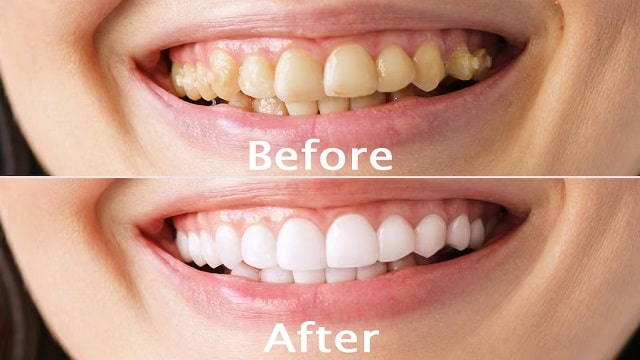What is Teeth Scaling?
Teeth scaling is a procedure to clean or remove tartar (hardened minerals) that sticks to the gum line.
This treatment is commonly done to protect tooth enamel under the gums and gum tissue from periodontal disease.
In addition, with healthy teeth and gums, you can also avoid other oral problems and tooth loss.
This procedure is also often performed together with root planing or is often also called deep cleaning.
While scaling removes tartar from the surface of the teeth that is visible when smiling, root planing removes tartar from the roots of the teeth below the gum line.
Purpose of Teeth Scaling
The scaling procedure has several objectives, namely:
- To remove plaque and tartar from areas that a toothbrush cannot reach.
- Avoid or prevent gum disease.
- Prevent pocket formation (pockets form when continued plaque buildup causes the gums to lose their tight contact with the teeth allowing more plaque to be deposited). The deeper the pockets, the more severe the gum disease progresses.
Side Effects of Teeth Scaling
Teeth scaling can also cause several side effects that may occur after this procedure, such as:
- Tooth sensitivity.
- Bleeding or red gums.
- Painful.
- Discomfort in the teeth.
- Tooth discoloration.
- Swollen gums.
- Possible infection.
These side effects are usually temporary and will disappear within a few days after the procedure. However, if symptoms persist or worsen, consult your dentist immediately.
Benefits of Teeth Scaling
In general, the benefits of teeth scaling are to make teeth clean and prevent various oral and dental diseases. Here are some of the benefits of teeth scaling that you need to know:
1. Prevent gum disease
Scaling can help reduce the risk of gum diseases such as gingivitis and periodontitis, which are caused by plaque and tartar buildup. By removing inflammation-causing bacteria, scaling can help maintain healthy gums.
2. Prevents the formation of tartar
Tartar forms when plaque that is not cleaned hardens. Regular scaling can prevent the formation of more tartar that cannot be removed by brushing alone.
3. Improve oral health
Scaling can help improve overall oral health by removing plaque and bacteria on the teeth.
4. Improves dental aesthetics
Scaling can help remove stains that stick to the surface of the teeth. Such as stains from coffee, tea, or tobacco, making the teeth look cleaner and whiter.
5. Prevent further tooth decay
By reducing plaque and tartar buildup, scaling can help reduce the risk of further tooth decay. Such as cavities (caries), because plaque that is not cleaned can damage tooth enamel.
6. Increase self-confidence
Cleaner and healthier teeth can increase a person’s confidence, especially when speaking or smiling.
7. Repairing tooth gaps
This procedure can correct gaps or pockets between the teeth and gums of an average of 0.5 millimeters. By reducing the pockets that form between the teeth and gums, it will reduce the risk of tooth, bone, and tissue loss associated with chronic periodontal disease.
8. Overcoming bad breath
By removing plaque and tartar, scaling can also reduce bad breath (halitosis) and improve breath freshness.
When to Scale?
When asked when to do teeth scaling, dentists will usually recommend teeth scaling and root planing if you have signs of chronic periodontal disease.
Signs of the disease can include swollen, red gums, sore to the touch, and easy bleeding.
Well, this procedure can help stop the harmful effects of this condition and maintain oral health.
Chronic periodontal disease occurs when bacteria in plaque cause the gums to pull away from the teeth. This causes large pockets to grow between the teeth and gums.
As a result, more bacteria can grow there, which cannot be reached by brushing your teeth.
If left untreated, chronic periodontal disease can cause:
- Loss of bone and tooth tissue.
- Loss of teeth.
- Loose teeth.
- Loose teeth.
Some things that can increase the risk of chronic periodontal disease are:
- Poor dental hygiene.
- Smoke.
- Aging.
- Hormonal changes.
- Malnutrition or poor nutrition.
- Family history.
- Other medical conditions.
Dental Scaling Procedure
The following is the scaling procedure starting from preparation, during treatment, until after the procedure is complete:
1. Preparation
The dentist will examine the overall condition of the teeth and mouth. Then the doctor will identify the location of plaque and tartar with the help of a special small mirror.
2. During the procedure
Then, using a vibrating tool called an ultrasonic scaler, the dentist will perform the scaling process. Here are the steps and stages in the scaling procedure:
- The vibrating metal tip on the scaler will remove tartar from the teeth above the gum line.
- The water spray on the tool will clean tartar and remove plaque from gum pockets.
- The dentist will use a scaler and a manual dental scraper (curette) to remove small pieces of tartar.
Teeth scaling and root planing may cause temporary discomfort after the procedure is complete. However, the risk of side effects from this procedure is considered very minimal. People with certain heart conditions, such as endocarditis, or who have a synthetic heart valve may need to take antibiotics before undergoing dental procedures. These medications can reduce the risk of bacterial infection. Ask your dentist and heart specialist if you need to take these precautions.
3. After the procedure
After scaling, your teeth may feel uncomfortable and sensitive for a few hours or days. To prevent infection and relieve pain, your dentist can prescribe medication.
Home dental care after scaling is also important to help prevent gum disease from becoming more serious or coming back.
This treatment includes brushing your teeth twice a day and flossing your teeth regularly.
You should also eat a healthy, balanced diet and see your dentist for regular cleanings to prevent tartar from coming back.

